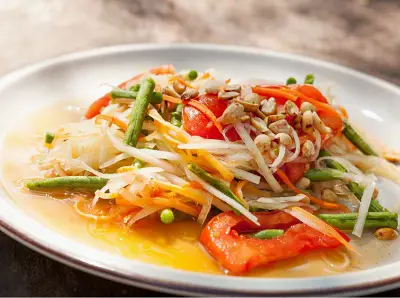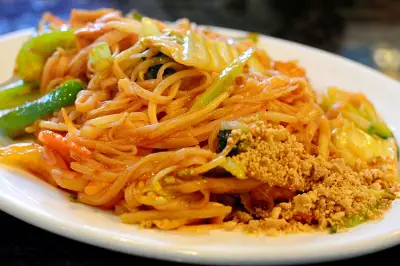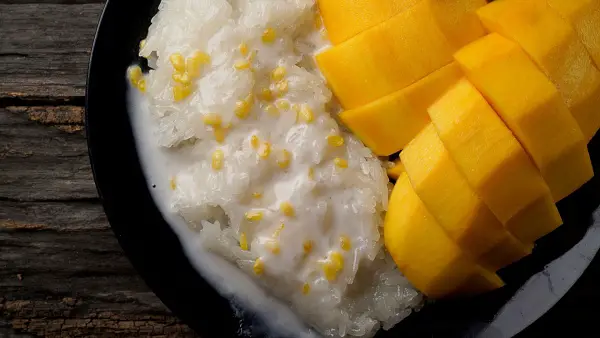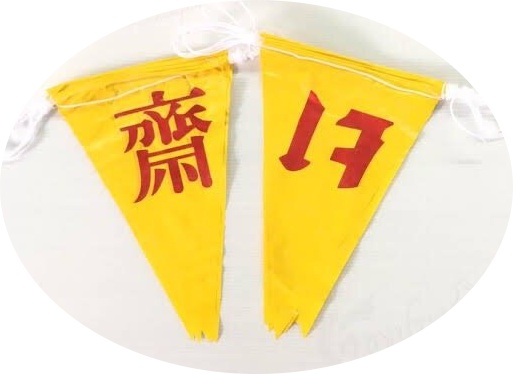Is Thailand Vegetarian Food available in Thailand? With a share of nearly 4% in the global culinary tourism market, culinary tourism is a primary revenue driver in Thailand. The country is a melting pot of culture and cuisines that’s why Thailand is considered a haven for food lovers. The sheer diversity of food to try can be overwhelming!
But what about the meat-free options? Are they easy to find? In Thailand, most dishes are seasoned with fish sauce, shrimp paste, and meat stocks. A meat-free dish isn’t 100% free of animal-based seasonings unless you specifically ask for it. This doesn’t mean there are no meat-free options for vegans and vegetarians. Finding good vegetarian or vegan restaurants is easy as asking for them.

What to Look for to get Vegetarian Food in Thailand
Ahan J (pronounced like a short Jey, not a long Jay) – is the commonly used term for vegetarian food in Thailand.
What you want to ask for when looking for vegetarian food.
How to order vegetarian food in Thailand? What dishes are 100% meat free? Look for the yellow sign to the right here…..
It looks like a red number 17 on a yellow background. Restaurants that have vegetarian food will have this symbol on their window or door or on the menu. There are vegetarian festivals in Thailand and eating vegetarian is taken seriously, people who are not vegetarian will eat only vegetarian dishes for 9 days. The festival is held around the end of September or the first of October. In 2023 it will be held from the 13th to the 22nd of October.
It is known as the festival of the Nine Emperor Gods – the festival is held every year and many Thai people follow a strict diet for those 9 days. My mother-in-law and daughter follow a vegetarian diet during this time. When the festival is held there are vegetarian foods available everywhere in Thailand.
But if you are here another time of the year, don’t worry there are plenty of vegetarian options available to you.
If you’re traveling to Thailand for a gastronomic adventure and you only prefer vegetarian dishes, we’ve made this guide for you.
Vegetarian Food in Thailand: How and What to Order?
How to Order Vegetarian Food in Thailand

Before ordering vegetarian options at a Thai restaurant, it’s essential to understand the correct terms so you can let servers know how to prepare the food accordingly to your liking. Many restaurants in Thailand have English-speaking staff members and menus with English text. But if you’re eating at a restaurant with no English-speaking staff, it is hard to explain how you’d like your food to be prepared.
“Ben mang sa wirat” (เป็นมังสวิรัต) is a loose term for someone who wants to avoid eating dishes with noticeable pieces of meat or seafood in them. The dish may be seasoned with meat stock, fish sauce, or shrimp paste, but it’s considered a vegetarian dish by not having meat in it.
If you want to order completely meat-free dishes – no eggs, meat, fish sauce, and other animal-based additives – your best bet is to order vegan food. In Thailand, a vegan is referred to as “khon gin jay” (กินเจ), someone who eats no meat, no seafood, no poultry, and no animal-based seasonings.
You can write the term on a piece of paper or use Google Translate to let the restaurant staff know you want the vegan option. To drive the point home, mention that you do not want any form of meat (“mai gin neua sat” ไม่กินเนื้อสัตว์), no fish sauce (“mai ow nam bplaa” ไม่เอานำ้ปลา) and no oyster sauce (“mai ow nam man hoy” ไม่เอาน้ำมันหอย) in any of the dishes you want to order.
Do note that when you refer to yourself as a “khon gin jay,” some herbs and vegetables may be omitted from the dishes because of their intense flavor or aroma.
Vegetarian Dishes to Order in Thailand
Most Thai dishes have meat, poultry, and seafood, but some can be prepared without animal protein. Staple dishes like salads, stir-fries, and curries can be altered with meatless substitutes like tofu, tofu, lentils, vegan meat, or local vegetables. Thailand, being a tropical country, has many kinds of fruits and vegetables throughout the season that vegans and vegetarians alike would enjoy.
What meatless dishes to order at a typical Thai restaurant? Here are some recommendations:
Gaeng om (แกงอ่อม)
Gaeng om is a light and fragrant soup made with red and green Thai curry coarsely grounded into pastes. Unlike typical Thai curry dishes, Gaeng om is neither heavy nor spicy because it doesn’t have coconut milk. Instead, it’s flavored with lemongrass shallots, garlic, galangal, and fresh, crisp vegetables. The dish originated in northeastern Thailand.
Traditionally, gaeng om is seasoned with fermented shrimp paste and has meat in them. But omitting shrimp paste and using tofu or other protein substitute makes this healing soup a tasty vegetarian dish.
Pad pak ruam prik gaeng (ผัดผักรวมพริกแกง)
Pad pak ruam prik gaeng is a traditional Thai dish consisting of local vegetables and meat seasoned with fish sauce and stir-fried in a paste made with chili and curry.
This dish can be easily modified for vegans and vegetarians by using meat substitutes and omitting animal-based seasonings. Pad pak ruam prik gaeng is popular among vegans and vegetarians because it’s filling, delicious, and nutritious. Served with steamed rice and Pad pak ruam prik gaeng makes a complete meal!
Som tam (ส้มตำไทย) and Som tam Boo Pla (ส้มตำปูปลาร้า)


Som Tam is a tangy, crunchy salad made from sliced green papaya, tomatoes, green beans, bean sprouts, local basil, and roasted peanuts seasoned with bird’s eye chilis, lime juice, fish sauce (or soy sauce), palm sugar, and dried shrimps.
Som Tam Boo Pla, is the same, but made with small river crabs (they just throw them in and pound them up, and fermented fish). It is a favorite with many Thai people and is very common to see.
Traditionally, Som tam is made by pounding the ingredients in a mortar and pestle to release the delicious aroma. It’s a sweet, sour, salty, crunchy salad with a spicy kick. This dish can be served as a side dish or with a side of sticky rice as a main course.
To order Som tam without meat, simply state “mai ow boo” ( I don’t want crab), “mai ow kung” heng (I don’t want dried shrimp), mai ow pla (I don’t want fermented fish).
It can also be ordered as Som Tam Thai. Be sure to say mai pet, or it may be too spicy for you to eat. Most sellers will ask to be sure what type of Som Tam you want.
Note: Som tam can be very spicy, if you are asked if you would like spicy and you are not used to spicy food, it is wise to say – “mai ow phet” ( I don’t want spicy). If you do like spicy food, I would still suggest that you go easy on the chilis and ask for one chili only. “Ow prik deow” One chili only.
Gang Jay (แก๊งค์เจ)
Gang Jay is a vegetarian curry dish made from local vegetables such as Thai basil, eggplants, sweet bell peppers, and bamboo shoots cooked in a curry-based sauce made from lemongrass, green curry, galangal, shallots, and coconut milk. The aromatic herbs and chili peppers add a nice kick of flavor to the dish while the creamy, umami sauce tempers the heat.
This dish is served with a heaping serving of tofu. Gang jay makes for a satisfying meal on its own but paired with steamed white rice; a serving can feed at least a couple of hungry vegetarians!
Vegetarian Pad Thai (ผัดไทย)

You cannot go to Thailand without sampling one of its most well-known dishes, Pad Thai. Pad Thai is a noodle dish stir-fried to perfection with rice noodles and vegetables in a tamarind-based sauce seasoned with dried shrimp, fish sauce, palm sugar, red chili peppers, and lime juice. Pad Thai is often topped with eggs and crushed peanuts.
The dish shown is with vegetables only. While I prefer my pad thai with chicken or shrimp it is equally delicious however you prefer it. Simply squeeze the lemon over the top to add a delicious tart flavor.
Normally Pad Thai has eggs, the dish can be changed easily to make it vegetarian-friendly. Some of the aromatics and seasonings will be substituted, and tofu makes a perfect alternative to eggs for texture.
Pad Thai is a filling meal on its own, but most restaurants serve it with a side of fresh salad and bamboo shoots. It’s rarely eaten with rice, but no one will stop you from trying if you’re feeling peckish.
Tao Hoo Song Kreung (เต้าหู้ ทรงเครื่อง) – Tofu
Tao hoo song kreung is a filling dish made with fried tofu cubes that are flash cooked in a wok with some vegetables in a rich, oyster-based sauce. Tofu has a mild flavor, but it absorbs the thick sauce like a sponge, becoming melt-in-your-mouth delicious!
Traditionally, Tao hoo song kreung has minced meat seasoned with fish sauce. But the minced meat can be substituted with mushrooms and fish sauce to soy sauce to create a delectable vegetarian dish. Tao hoo song kreung is quite filling. However, this dish is often eaten with steamed white rice.
Pak Boong (ผักบุ้ง)
Pak Boong is a dish made by stir-frying pad pak boong or water spinach in a spicy sauce seasoned with fish sauce, oyster sauce, and hot chili peppers. The crunchy water spinach goes well with the sweet, spicy, and savory sauce. Pak boong is typically served as a side dish, but it can be eaten as a main meal with a cup of rice (or two!).
On its own, pak boong is considered a vegetarian dish because it’s meatless, but some seasonings are made with seafood. There are many subs to make this dish vegan-friendly, like using fermented bean paste as an alternative to oyster sauce.
Pad gra pao het jay (ผัดกระเพราเห็ดเจ)
Pad gra pao het jay is a vegetarian dish made with mushrooms (het). Be sure to ask for the J version of the dish, as it is often prepared with meat.
Note: Pad gra pao het, nua, or gai is an aromatic dish typically made with ground beef or chicken cooked stir-fry style in a brown sauce seasoned with dark and light soy sauce, fish sauce, and oyster sauce. The main ingredient is Thai holy basil, an aromatic herb that gives this classic Thai dish a distinct aroma.
Because pad gra pao het jay is a classic Thai dish, most food hawkers have it in their daily offerings. It’s often served with a fried egg topping and eaten with rice. Tell the server to hold the meat and egg topping and ask for tofu (Tao hoo) alternatives to order.

Khȃo Nǐaw Má-mûang (ข้าวเหนียวมะม่วง )
You can’t miss the ubiquitous dessert Khȃo Nǐaw Má-mûang or mango sticky rice, because it’s all over Thailand. This yummy dessert is made by steaming lightly salted sticky rice with creamy coconut milk and served with generous slices of ripe mango. Mango with sticky rice is delicious, the danger is eating too much of the sticky rice with coconut milk – it is so good.
It is often served with yellow mung beans on top which adds a nice crisp crunch to the sticky rice.
This dessert doesn’t have to be modified in any way because it’s vegan and vegetarian friendly. Every food hawker serves this dessert, so ordering one for a quick and filling snack is easy. We suggest visiting Thailand during the mango season to enjoy this seasonal dessert!
Roti (โรตี)
Another classic Thai dessert is roti, a pan-fried flatbread of Muslim or Indian origins. This bread is served either as a dessert or as a savory snack. Dessert roti is often stuffed with milk, peanut butter, chocolate spread, or fruits or fruits in season and is best enjoyed with a cup of brewed coffee. The savory kind is stuffed with cheese, sweet corn, and eggs.
Roti is very good and can be surprisingly sweet. My daughter often brings back a roti for me after work that has banana, sweetened condensed milk, and chocolate syrup. Delicious, I always ask her not to bring them, because I am obligated to eat them (I don’t mind, but I should not eat too many of them).
Most food hawkers make a performance of kneading and stretching the dough before laying it on a buttered grill. It’s fascinating to watch! Roti’s ingredients are simple, and without animal-based additives, it’s totally vegetarian-friendly.
Are Vegetarian foods easy to find in Thailand?
There are many vegetarian options in Thailand, but you must be specific about the food prep to avoid meats or animal source foods. It is true, seafood sauces or meat-based broths are everywhere in Thailand and can easily be added to a dish. However, if you specify that you wish to eat – Ahan J – then the restaurant will know that you are serious about being vegetarian and will prepare your food accordingly.
Obtaining Vegetarian Food In Thailand?
Start by learning local terms for vegan and vegetarian and letting your server know you do not eat meat, poultry, or seafood. To be safe, choose vegan options to avoid animal-source seasonings in your food. Look for the red 17 on a yellow background.
- To say you do not eat seafood – Mai gin ahan talay. (No eat food sea). Translates as I do not eat seafood.
- To say you do not eat meat – Mai gin ahan nua sat. (No eat meat animal) Translates as I do not eat meat.

How to find vegetarian food in Thailand?
Most locals would point to food vendors around temples and monasteries because many Thai Buddhist monks are vegan. These are great places to start. You can also check clusters of food hawkers with a vegetarian symbol. The symbol is the word “เจ” or Jay, written in red text over a yellow background. Food stalls with pictures of Thai monks or Buddhas are vegan-friendly. If all else fails, learn the local term for vegan to let restaurants know you don’t eat meat.
Thailand’s food culture is vibrant and diverse. There is something for everyone, including vegans and vegetarians. With these tips, you can experience Thailand’s unique vegetarian dishes to the fullest!
In Summary
Vegetarian food is available everywhere in Thailand. Simply ask for – Ahan J. Look for the yellow signs that show that the restaurant and or food stall has vegetarian food. You will find them everywhere. There are many vegetarians in Thailand and many restaurants cater to them.
We have provided a few well-known Thai dishes for your vegetarian experience while here in Thailand. For more flavors and experiences, see our upcoming article on Indian food in Thailand. Many Indian food restaurants offer vegetarian food.
If you arrive during the festival of the Nine Emperor Gods (October 9 to 22 in 2023), then vegetarian food will be everywhere. You will see stalls set up in shopping centers and street markets. There will be every kind of vegetarian food imaginable. Thailand has a vibrant vegetarian community and many people love to eat vegan. You will not be disappointed.



